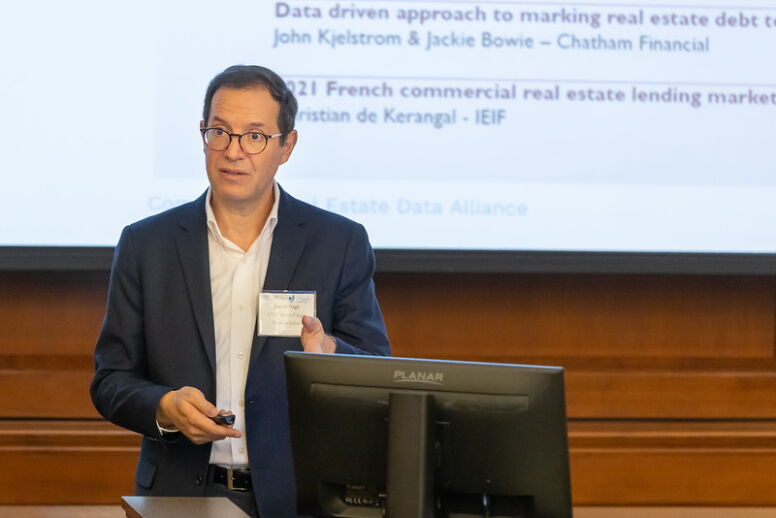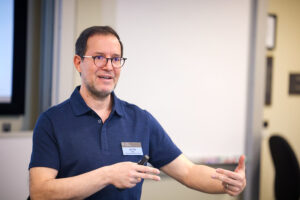News & Stories
Understanding commercial real estate

Professor Jacob Sagi has long been intrigued by questions about the future of real estate – a major economic driver – that are beginning to take on new significance.
With a deep-rooted passion for commercial real estate extending back more than a decade, his focus is now sharpening.
Recent media coverage has highlighted concerns regarding commercial real estate, particularly among small regional banks in the U.S. There’s also growing speculation about the future of office space in the post-Covid era, and the evolving landscape of the built environment amid technological advancements.
“There is increasing interest in this asset class from a macro and mainstream perspective,” says Sagi, professor of finance and Wood Center in Real Estate Distinguished Scholar at UNC Kenan-Flagler Business School. “It’s a very important asset class that is hiding in plain view. Add up the total value of real estate, it’s larger than the U.S. stock market. It’s also a very important part of people’s ownership portfolio.”
Despite that, Sagi argues that in business school settings, real estate has not received as much of a footprint compared to other areas or assets. The issue is a lack of data.
“There’s a lot of data about public equities, bonds, commodities and foreign exchange. And by comparison, commercial real estate is mostly held in private hands. So the data is not easy to access,” says Sagi.
It’s a different story at UNC Kenan-Flagler, which has a long-time commitment to real estate studies and research through the Leonard W. Wood Center for Real Estate Studies.
Sagi is a passionate researcher. One of his most-cited recent papers explores how risky it is to invest in real estate assets. “You can download a lot of information on stock prices online, but real estate assets don’t trade very often. So you’ll never get enough data to convey a sense of just how pronounced the risk might be. This bothered me,” he says.
A key finding of the paper is that individual properties exhibit a risk similar to that of stocks– something called a “random walk” risk, which grows with the holding period.

Sagi speaks at a UNC Kenan-Flagler Alumni Weekend event.
A typical property investment, however, only bears perhaps half as much of this risk as, say, a blue–chip stock. But there is an additional risk linked to liquidity that is absent from blue chip stocks. “I call it transaction risk,” Sagi says. “You need to wait for a buyer to come along, and that introduces extra risk. The actual transaction price has a standard deviation of 12% relative to a fair-market valuation. The total transaction risk baked into property investment amounts to two or three years of the property’s stock-like risk. That’s why flipping properties is an incredibly risky strategy.”
Alongside his research, Sagi is a fervent educator, teaching in UNC Kenan-Flagler’s real estate concentration. “The classes introduce students to commercial real estate as an investment asset class and how professionals carry out the cash flow analysis for properties,” he says.
He also teaches a class on real estate capital markets, exploring the role real estate plays in the real economy, through Real Estate Investment Trusts (REITs) and mortgaged-backed securities.
Sagi’s background in physics laid the foundation for his teaching real estate. He earned a PhD in physics, but felt it was too niche for a career path. “The only way to succeed as an academic in physics was to chase down problems that were solvable, and they were mostly esoteric and not that interesting to me. I wanted to study important things,” he says.
At the time, the financial sector was hiring “tons of physicists” to work on options, derivative instruments and mortgage-backed securities. Sagi followed the money, applying for a job at Canadian financial institutions. He knew little about that world, so he read up. “I was teaching at a small college in Vancouver and they had a book in their library on the fundamentals of corporate finance. It was surprisingly intellectually stimulating.”
The experience eventually led him to pursue a second PhD, this time in finance at the University of British Columbia. “I realized I burnt out of physics but not academia,” Sagi says.
He joined the faculties at the Haas School of Business at University of California, Berkeley and Owen School of Management at Vanderbilt University before he joined UNC Kenan-Flagler in 2013, attracted by its very strong finance area faculty. An added bonus was being closer to his wife’s family nearby in Wake Forest, North Carolina.
“The environment is different from any other school,” says Sagi. “I have not seen the level of engagement from real estate students or alumni like I have here. The alumni, in particular, are willing to give more than just money – they are also eager to invest their time to support the program. It’s breathtakingly refreshing.”
Outside of academia and raising a family, he tries to find time to indulge his second passion: classical piano.
“Before I went down the path of physics, I had the ambitions of becoming a musician,” he says. “I hurt my hand and I had to let go of that dream. But I was actively playing chamber music before the kids were born. Now when I sit at the piano, one of our twins usually comes over and pushes me off, so that they can play a few notes. I’m happy to let them do that.”